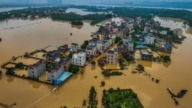【新唐人2014年10月17日訊】中國是世界上建造水壩數量最多的國家。近年來,隨著水壩所引發的自然災害,以及對生態環境的破壞等問題逐漸凸顯,使得水壩的負面影響越來越受到人們關注,針對水壩工程建設的質疑還有反對聲浪也愈發強烈。日前,一座耗資600多億元,號稱「全球第二大水壩」的水電站在中國大陸的藏區宣佈開工後,引發了巨大爭議。
據大陸媒體報導,總投資664億元的中國藏區綜合規模最大的水電工程——四川雅礱江兩河口水電站,10月6號宣佈正式開工,工期10年。據了解,兩河口大壩壩高295米,是目前中國第一高的土石壩,也是全球第二大水壩,壩體總填築量相當於6個「鳥巢」的體積。
儘管當局聲稱,兩河口水電站建成將會「對下游電站產生巨大的補償調節效益」、「極大改善川渝電網的不合理電源結構」、還能「進一步改善長江上游生態環境」、「增強長江下游防洪能力」等等。但相關專家指出,當局僅僅從水電站本身能起到的有利作用來強調工程的可行性,卻完全迴避了水電站建設,所帶來的巨大而長遠的不利影響。
環保志願者民間水利專家張俊峰:「從我們現在幾十年,甚至於工業革命以來到現在為止,我們可以看到很多我們自認為比較穩妥的一些工程措施甚至科學發現,都造成了人類現在的這種環境、生態和自然的一些變化。而有些變化是我們現在還沒有認識清晰的,也是無力承擔的一些東西。」
多數水利、地質和環保專家們認為,水壩的建設,往往是弊遠大於利,其中首當其衝的就是對生態環境的破壞。例如長江上密密麻麻的各級水電站,將長江上游變成了一層層「梯田」,造成了很多洄遊魚類的滅絕,其中包括被稱作「水中活化石」的古老珍惜魚類「中華鱘」。
張俊峰:「從生態的角度來說,由於人為的將河流阻斷了之後,使得水體的水生態環境被人為地阻斷了。有一些生物體,我們所看到明顯的就是一些洄遊的魚類,被阻斷了洄遊的通道。還有一些其他的,包括水生的微生物和一些其他的微小生物體,也都阻斷了它的移動狀態。而一旦破壞這樣生態系統的一些流動的狀態,就會打破當地的一些生態平衡。」
據官方環境評價報告顯示,兩河口水電站項目施工後,至少將有28種國家級珍稀保護動植物的棲息地受到破壞。但環保人士認為,官方的環評過於片面,並沒有把水電工程對生態造成的真正危害公開。
江蘇的環保人士吳立紅:「我認為建造大壩一定要通過論據的,要有周邊百姓的同意,要有相關科學數據拿出來,要拿出真實的環境報告,環境評價要公開,現在我們大陸的環境評價都是假的呀!它為了(工程)要通過,所以下面的一些政府機構它就搞假的環評。」
除了對物種、水體、氣象等生態環境造成的影響和破壞,水壩對於地質的影響也是極為巨大的,由此而導致的地震、山體滑坡、泥石流、洪水等自然災害也屢屢發生。
張俊峰:「雅礱江地區屬於地質比較活躍的地帶,如果要是一旦建設一些水電站的話,勢必對地質的狀況會產生一些干擾,而這種干擾一定會對當地的地質產生一些影響,而且是比較深刻的影響。我認為這種影響會有可能引發一些諸如地震或者其他的一些地質上的一些危害。」
如果說,對於「全球最大壩」——長江三峽工程持續幾十年的爭議僅僅限於專家學者的範圍,那麼「全球第二大水壩」兩河口水電站宣告的開工,則引發了更大範圍的爭議,網路上出現了一面倒的反對聲音。
網民們有的怒罵當局「禍害地球,不顧及子孫後代」﹔有人「坐等生物滅絕」﹔有的反問「為何國外在拆,中國在建?」﹔有人嘲諷「又肥了哪個利益集團?」有居住在水庫區的網民則質問當局「當初的承諾,為何至今無一兌現?」
採訪/田淨 編輯/張天宇 後製/李智遠
China Starts Building Controversial Dam in Tibet
China owns the largest number of dams in the world.
The prominent issues of natural disasters and ecological
destruction from the dams have brought more questions
and strong opposition to hydropower.
Construction on the largest in dam in Tibet, costing over
60 billion yuan ($9.8 billion), is stirring intense controversy.
Mainland media report that construction on the $10.8 billion
hydropower station on Yalong River in Sichuan
began on Oct. 6, and is expected to be completed in 2023.
The dam will be 295 meters high, and will be the tallest dam
in China and the second tallest in the world.
The dam will have a total filling volume equal to six
Bird’s Nests, Beijing’s Olympic Stadium.
The authorities say that the hydropower station will improve
the adjustment capacity of downstream stations,
the imbalanced Chongqing power grid structure,
the ecological environment of the Yangtze River’s
upper reaches, and the Yangtze River flood control capacity.
But experts say the benefits were only mentioned
to emphasize the feasibility of the construction,
while the long-term adverse effects of the station
are completely being ignored.
Zhang Junfeng, water resources expert: “For decades now,
since the Industrial Revolution and even up to now,
we can see that a lot of what we believed,
in terms of the engineering and scientific development,
have changed our environment, ecology and nature.
We have yet to understand some of these changes,
and we are completely unable to handle them."
Most experts in water conservancy, geology and environment
believe that the construction of dams often do more harm
than good, particularly when it comes to ecological damage.
For example, dense hydropower stations on the Yangtze River
have turned areas upstream of the river into layers of “terraces",
pushing many migratory fish to extinction, including the fish
known as the “living fossil in the water," the Chinese sturgeon.
Zhang Junfeng: “From an ecological perspective, the dam has
artificially destructed the ecological environment in the water.
The channel of the migration for some organisms,
such as the migratory fish, have been blocked.
Some water born microorganisms and other tiny organisms
are also blocked of its mobile state.
Once the flow of the ecosystem is destroyed,
so to will the local ecological balance."
The official environmental assessment report shows that
after the construction of dam, the habitat for at least 28 kinds
of rare and protected plants and animals of the national level
will be destroyed.
But environmentalists say that the official assessment is too
one-sided, and hasn’t fully revealed the true ecological harm
of the hydropower project.
Wu Lihong, environmentalist in Jiangsu: “I think construction
of the dam must pass arguments, have consent of neighboring
residents, consider scientific data, and environmental reports;
the environmental assessment must be made public.
Now the environmental assessments in China are fake!
In order to pass projects,
the government agencies make up fake assessments."
Other than the impact and damage to species of life, water,
and weather, the ecological destruction caused by dams
is also huge, leading to frequent natural disasters
such as seismic activity, landslides, mudslides, and floods.
Zhang Junfeng: “Yalong area belongs to the more active
geological zones, the construction of dams is bound to produce
some geological interference, which will have more profound
impact such as earthquakes or other geological hazards."
If the construction of the Yangtze River Three Gorges Project,
“the world’s largest dam," has caused decades of controversy
among experts and scholars, the Yalong River dam has caused
even wider disputes among the public since its construction.
Many netizens posted online criticisms of the authorities,
saying, “scourge of the earth, disregarding present
and future generations"; “waiting for extinction";
“Why they are being demolished overseas, but built in China?";
and “which interest groups have been benefited?"
A resident around the reservoir area questioned the authorities:
“Why hasn’t even one promise ever been honored?"
Interview/TianJing Edit/Zhang Tianyu Post-Production/Li Zhiyuan



























